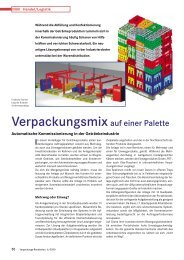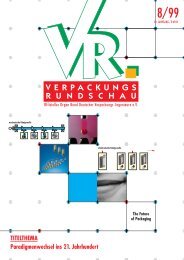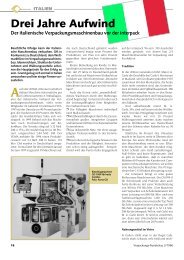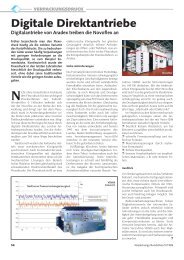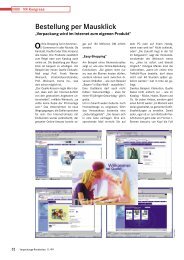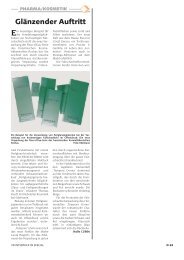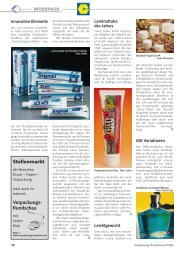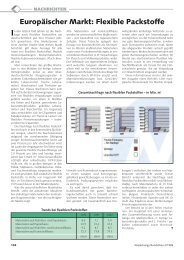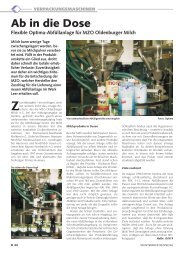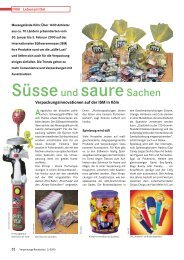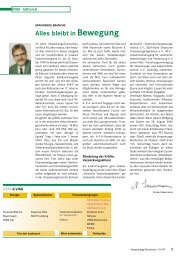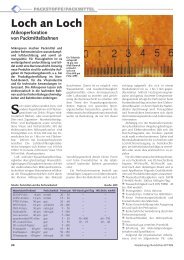At the Cutting Edge of Beverage Filling - Verpackungs-Rundschau
At the Cutting Edge of Beverage Filling - Verpackungs-Rundschau
At the Cutting Edge of Beverage Filling - Verpackungs-Rundschau
You also want an ePaper? Increase the reach of your titles
YUMPU automatically turns print PDFs into web optimized ePapers that Google loves.
LABELLING<br />
Marketing Label Papers<br />
by Manfred Marschner*<br />
Beyond performing a necessary and legally<br />
required role, labels today have<br />
gained tremendous importance in product<br />
marketing. They convey <strong>the</strong> value<br />
<strong>of</strong> a product, contribute to its image,<br />
are <strong>the</strong> major vehicle <strong>of</strong> a brand.<br />
Today’s label papers are <strong>the</strong> result <strong>of</strong><br />
a continual development in quality<br />
standards which have to meet a wide<br />
number <strong>of</strong> challenges in <strong>the</strong> areas <strong>of</strong><br />
print and finishing, labelling, ease<br />
<strong>of</strong> removal from bottles, and finally<br />
recycling <strong>of</strong> used labels.<br />
Technical Aspects <strong>of</strong> Label Papers<br />
Labels are made <strong>of</strong> one-side coated<br />
papers. A basic distinction is drawn between<br />
machine-coated and cast-coated<br />
papers and between wet strength and<br />
alkali-resistant papers on <strong>the</strong> one hand<br />
and non-wet strength papers on <strong>the</strong> o<strong>the</strong>r.<br />
Wet strength and alkali resistant<br />
papers are used to label refillable and<br />
one-way bottles In this area, base papers<br />
for metallisation represents a significant<br />
special category.<br />
Non wet strength papers are used for<br />
labelling and packaging under dry and<br />
warm conditions – mainly for labels<br />
and banderoles, but also for chocolate<br />
wrappers, cigarette s<strong>of</strong>t packs, etc. and<br />
for lamination.<br />
Cast-coated papers are used in <strong>the</strong> labelling<br />
<strong>of</strong> high-class drinks, such as wine,<br />
champagne, etc., in addition to a variety<br />
<strong>of</strong> foodstuffs. Their extremely high-gloss<br />
finish bestows on <strong>the</strong> product a high sense<br />
<strong>of</strong> value, whilst <strong>the</strong> uncoated side is<br />
eminently suitable for <strong>the</strong> labelling process.<br />
Cast-coated papers are also used in<br />
<strong>the</strong> manufacture <strong>of</strong> self-adhesive labels.<br />
The European market for one-side<br />
coated papers is about 500000 t, approximately<br />
2.5% <strong>of</strong> <strong>the</strong> total paper market. In<br />
recent years, <strong>the</strong> market for machinecoated<br />
label papers has seen only slight<br />
average growth <strong>of</strong> 2-3%, whilst sales <strong>of</strong><br />
wet strength and alkali-resistant papers<br />
have grown only in line with <strong>the</strong> low<br />
growth in <strong>the</strong>ir application areas. The use<br />
<strong>of</strong> cast-coated papers in labelling has<br />
stagnated.<br />
*Managing Director <strong>of</strong> Stora Fine Paper Deutschland<br />
Composition <strong>of</strong> a Label Paper<br />
Label papers are made up <strong>of</strong>: base<br />
paper, surface coating and treatment<br />
<strong>of</strong> <strong>the</strong> reverse side. Base papers are<br />
predominantly high quality, wood-free<br />
papers. However, papers containing a<br />
small proportion <strong>of</strong> mechanical fibres are<br />
used in some areas (e.g. for labelling wine<br />
and s<strong>of</strong>t drinks).<br />
The surface coating consists mainly <strong>of</strong><br />
pigments and binding agents to achieve<br />
optimal printing characteristics. Fur<strong>the</strong>r<br />
additives serve to adjust whiteness, water<br />
and alkali resistance, resistance <strong>of</strong> <strong>the</strong><br />
printing inks to wet abrasion, alkali-bath<br />
ink retention etc.<br />
The main purpose <strong>of</strong> <strong>the</strong> reverse side<br />
treatment is to reduce as far as possible<br />
curling which results from coating one<br />
side <strong>of</strong> <strong>the</strong> paper and to ensure optimum<br />
flatness when <strong>the</strong> paper is exposed to<br />
varying ambient conditions, adhesive and<br />
moisture. It is also used to adjust water<br />
absorption and wetting properties and<br />
thus adhesive curing times. Finally, it can<br />
be specifically used to influence <strong>the</strong> diecutting<br />
properties <strong>of</strong> <strong>the</strong> paper.<br />
The main properties <strong>of</strong> label papers can<br />
be divided into <strong>the</strong> categories “Print and<br />
Finishing” and “Labelling”.<br />
Print and finishing: <strong>the</strong> optical<br />
qualities <strong>of</strong> whiteness, smoothness and<br />
gloss are critical to printing quality.Whiteness<br />
and gloss are important for brilliant<br />
colour reproduction,whilst smoothness is<br />
decisive for highly accurate reproduction<br />
and optimum resolution.<br />
Processing characteristics are mainly<br />
influenced by flatness, sheet separation<br />
and <strong>the</strong> stiffness <strong>of</strong> <strong>the</strong> paper.<br />
Label papers are largely <strong>of</strong>fset printed,<br />
but <strong>the</strong> upper, coated side, must be suitable<br />
for <strong>of</strong>fset and rotogravure printing.<br />
They must also be suitable for subsequent<br />
lacquering with water-based dispersion<br />
lacquers, solvent-based lacquers and<br />
ultraviolet lacquers. For wet strength and<br />
alkali-resistant label papers <strong>the</strong> printing<br />
ink must be well fixed to ensure good ink<br />
adhesion in alkali-bath bottle cleaning.<br />
Labelling: optimum flatness and good<br />
label separation are basic requirements.<br />
In <strong>the</strong> case <strong>of</strong> non wet strength label<br />
papers, good sizing is necessary to prevent<br />
glue bleed when adhesives are applied<br />
to <strong>the</strong> whole surface. Moreover, <strong>the</strong>se<br />
papers must not contain substances<br />
which might produce corrosion when in<br />
contact with cans. The wet strength level<br />
required <strong>of</strong> a label paper depends on <strong>the</strong><br />
speed <strong>of</strong> <strong>the</strong> labelling process and <strong>the</strong><br />
filling conditions. Wet surfaces or condensation<br />
must not result in creasing and <strong>the</strong><br />
original gloss <strong>of</strong> <strong>the</strong> label paper must be<br />
retained. In addition, a label must retain<br />
its good appearance, even when exposed<br />
to condensation or when immersed in<br />
ice-cold water. Especially <strong>the</strong> so-called<br />
wet opacity (intransparency) is crucial for<br />
<strong>the</strong> optical appearance <strong>of</strong> <strong>the</strong> label under<br />
such conditions.<br />
Ano<strong>the</strong>r extremely important characteristic<br />
is <strong>the</strong> alkali-resistance <strong>of</strong> <strong>the</strong><br />
paper. When exposed to <strong>the</strong> alkaline solutions<br />
used in bottle cleaning, <strong>the</strong> label<br />
must come <strong>of</strong>f <strong>the</strong> bottle very quickly yet<br />
it must not disintegrate.<br />
Labelling Trends<br />
In <strong>the</strong> mid-80s, beer was mainly bottled at<br />
temperatures <strong>of</strong> between 3 and 4°C. This<br />
resulted in <strong>the</strong> formation <strong>of</strong> heavy condensation<br />
on <strong>the</strong> bottles and produced<br />
a need to use casein adhesives. To avoid<br />
labelling problems, especially creasing,<br />
<strong>the</strong> water absorbency <strong>of</strong> <strong>the</strong> reverse <strong>of</strong> <strong>the</strong><br />
label had to be kept low. Labelling speed<br />
has brought about fur<strong>the</strong>r changes. These<br />
days, bottling machines are no longer operated<br />
at maximum speed. Today,average<br />
bottling performance is in <strong>the</strong> order <strong>of</strong><br />
45000 bottles per hour. In recent years,<br />
bottling temperatures in many breweries<br />
have been raised to between 10 and 14°C<br />
due to <strong>the</strong> introduction <strong>of</strong> ‘flash pasteurisation’<br />
to extend shelf-life and to <strong>the</strong> use<br />
<strong>of</strong> sealed crates, which make it necessary<br />
to minimise condensation on bottles.<br />
This development permitted <strong>the</strong> use <strong>of</strong><br />
adhesives with reduced casein content,<br />
making it necessary to modify <strong>the</strong> water<br />
absorbency <strong>of</strong> <strong>the</strong> reverse side <strong>of</strong> label<br />
papers.<br />
The steadily increasing use <strong>of</strong> light,thin<br />
glass and light plastic bottles (especially<br />
PET) for s<strong>of</strong>t drinks and mineral waters<br />
represents a fur<strong>the</strong>r trend.<br />
Germany and o<strong>the</strong>r European countries<br />
are now seeing <strong>the</strong> introduction <strong>of</strong> returnable<br />
PET bottles.Paper labels are well<br />
suited for labelling this new form <strong>of</strong><br />
packaging. ❐<br />
VR <strong>Beverage</strong> Packaging 1997 29



